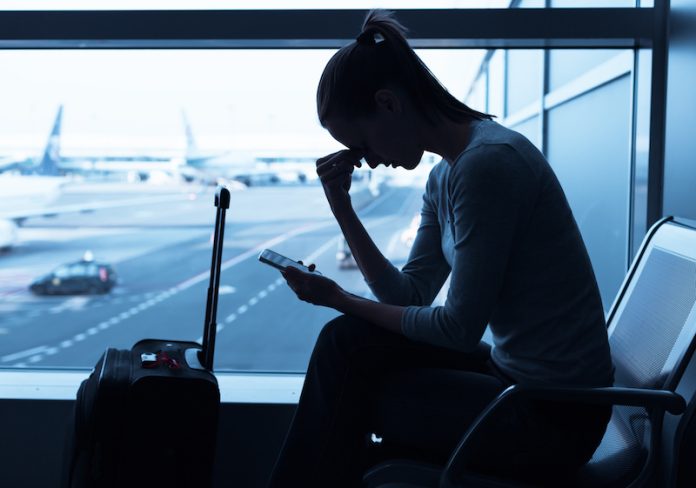Many of us experience anxiety before a flight. Even under the best possible circumstances, air travel seems designed to stoke apprehension: going through heightened security protocols, having to sit in a seat that seems to get narrower on every flight (if you’re in economy, anyway), and being stuck hip-to-elbow with strangers who may or may not understand basic courtesies like using headphones to watch movies or not reclining their seat into your lap.
To make things worse, a recent wave of flight complications and air travel concerns have increased traveler concerns to heightened levels. With all that, it’s natural if you’re looking at Amtrak schedules for your next trip. But despite recent events, flying is still one of the safest modes of travel.
Here’s how to get over plane anxiety the next time you board without having to see your doctor for a prescription or worry about being zonked out upon your arrival.
- Get the facts. The average American’s annual risk of perishing in a plane crash is 1 in 11 million. You take a bigger risk every time you get in a car. If that doesn’t help, think about all the planes that don’t crash. There are more than 45,000 flights scheduled every day just in the United States, and it’s been estimated that there are between 7,782 and 8,755 commercial planes in the air worldwide at any moment. That’s a lot of planes getting to their destinations intact.
- Learn how airplanes work. Understanding the mechanics of flight takes the mystery out of how planes stay in the air and can help tamp down fears. In a nutshell, plane wings are designed so that air moves faster over the top, decreasing the air pressure there. This means the pressure on the top is less than the pressure on the bottom of the wing, which results in the wing lifting into the air. Pretty neat if you think about it! You could also research the many safety features on modern planes, including some you may not have known about.
- Know your triggers. Turbulence strikes fear in many people, especially when that seatbelt light goes on. So can weird noises like the landing clear going up or down. Others may think they perceive worry on flight attendants’ faces or other signs that something’s wrong. Being prepared with some rational answers to these can help keep your anxiety from spiraling. It’s extremely rare for turbulence to cause structural damage to a plane (although it can cause injuries inside the cabin, which is why you should obey those seatbelt announcements), airplane parts and functions can be noisy, and most likely the flight attendants are worried about something like a demanding passenger in first class or whether they’re going to run out of the chicken entree.
- Be prepared for mechanical delays. Minor mechanical issues do happen. It doesn’t mean that the plane is going to fall apart. After all, it’s good when mechanics identify a problem ahead of time. Usually, they can quickly fix it before takeoff or alert the airline that they need to switch out the aircraft.
- Distract yourself. There’s nothing like getting lost in a good book, a podcast, or a crossword puzzle, which may be preferable to on-air entertainment that could be interrupted by flight announcements.
- Do meditation and calming exercises. Breathing exercises can help quell anxiety and quiet the mind. The 4-7-8 breath is particularly effective for calming the nervous system. Download a meditation app or try different techniques to see what works for you.
- Select your seat wisely. An aisle seat may help you feel less claustrophobic, while others may prefer to be nearer the front of the plane or by an emergency exit.
- Fly with a confident friend. Admittedly this is not always possible, but if you’re traveling with someone who doesn’t mind flying, you may find comfort in their sense of security. It’s even better if they know how to help with flight anxiety.
- Consider exposure therapy. Taking short flights could help you build up a greater tolerance and prepare you for longer flights. If your anxiety becomes truly debilitating, you could work with a trained therapist to address your fears.
- Choose airlines with the best safety records. As of 2024, the top five safest airlines were Air New Zealand, Qantas, Virgin Australia, Etihad Airways, and Qatar Airways. Among U.S, carriers, Alaska Airlines was at number 10 Hawaiian Airlines at 21, American Airlines at 22, and United Airlines at 25. Of course, sticking to these could mean curtailing where you can go—so remember that the “safest” designation is relative. It is still highly unlikely that you will be involved in a major incident even if you fly airlines at the bottom of the list.
The investigation into Boeing’s safety practices is putting all aircraft manufacturers and airlines on extra high alert, so flying may be even safer than usual right now. That said, it can be hard to convince your rational brain that the risk is low. Knowing how to deal with anxiety about flying and trying out these tactics to relax your brain and body may help you get through—or even enjoy—your next flight. And if not, hopefully you at least have a fun destination or a welcoming home to look forward to at the end of it.
By Heather Kenny

